Translate this page into:
An initiative for better patient handling and process evolution using BD Vacutainer® UltraTouch™ Push Button Blood Collection Set with Pre-Attached Holder
*Corresponding author: Dhruv Mamtora, Department of Laboratory and Infection Control, Bai Jerbai Wadia Hospital for Children, Maharashtra, India. dhruv_mamtora@yahoo.com
-
Received: ,
Accepted: ,
How to cite this article: Mamtora D, Ghogale S, Solanki S, Sawant M. An initiative for better patient handling and process evolution using BD Vacutainer® UltraTouch™ Push Button Blood Collection Set with Pre-Attached Holder. Wadia J Women Child Health. 2023;2(3):108-15. doi: 10.25259/WJWCH_28_2023
Abstract
Objectives:
Venepuncture and intravenous cannula insertions frequently cause pain and anxiety in paediatric patients. Various studies have observed that higher gauge and shorter needles are less painful, and the likelihood of bleeding was decreased compared to the lesser gauge needles. Hence a study was designed with objective of evaluation of BD UT PBBCS – PAH (latest blood collection device) for pain perception of paediatric patients.
Material and Methods:
The current study was conducted at the outpatient department of Bai Jerbai Wadia Hospital for Children. In this study, 33 paediatric individuals were included. Venepuncture was performed with UTPBBCS-PAH (25G) and after the procedure feedback was collected. Pain perception feedback was gathered using a categorical scale ranging from 0 to 5, also known as the “verbal pain intensity scale”.
Results:
The current study found that pain intensity was significantly lower with UTPBBCS-PAH, and the overall experience was less traumatic.
Conclusion:
The UTPBBCS is deemed to be the appropriate blood collection device for the paediatric population due to design elements contributing to less painful experience.
Keywords
BD Vacutainer® UltraTouch™ push button blood collection set with pre-attached holder
Pediatric
Difficult venous access
INTRODUCTION
Venipuncture and intravenous (IV) cannula insertions frequently cause pain and anxiety in pediatric patients.[1,2] A previous study revealed that both fear and anxiety during the blood collection process diminished patient cooperation, resulting in multiple pricks.[3] Anxiety levels were associated with the anticipation of discomfort during the waiting period before venipuncture.[4] About 10% of the population is affected by needle phobia,[5] often to the extent that they avoid necessary treatments to evade venipuncture. There is evidence of fatal incidents due to needle phobia and its associated vasovagal reflex during the procedures.[6-17] These issues can be alleviated with the use of shorter and higher gauge needles. The BD UltraTouch™ Push Button Blood Collection Set with Pre-attached Holder (UTPBBCS-PAH) has been designed to address the problem of pain perception. It was observed that higher gauge and shorter needles are less painful, and the likelihood of bleeding was decreased compared to the needles with a lesser gauge.[18] In addition, butterfly needles have been found to be less painful and less likely to cause nerve damage.[19] The needle gauge, specifically its smaller outer diameter, contributes to the level of pain experienced by the patient.[20] A smaller outer diameter of the blood collection needle causes less penetration pain compared to needles with a larger outer diameter. [18,21] It is worth noting that healthcare professionals may be hesitant to use smaller gauge needles like 25 gauge (25G), despite the benefits in accessing difficult veins, due to concerns about prolonged tube filling time and an increased incidence of hemolysis.[20] The previous studies showed that a 25G needle should be recommended for selected circumstances, and potential biases related to its use should be considered when interpreting results.[22] In the present study, the UTPBBCS-PAH (25G) needle was used, where the inner cannula is similar to a 23G needle. This technology is known as RightGauge™ ultra-thin wall technology, which reduces penetration force and improves fill time [Figure 1].
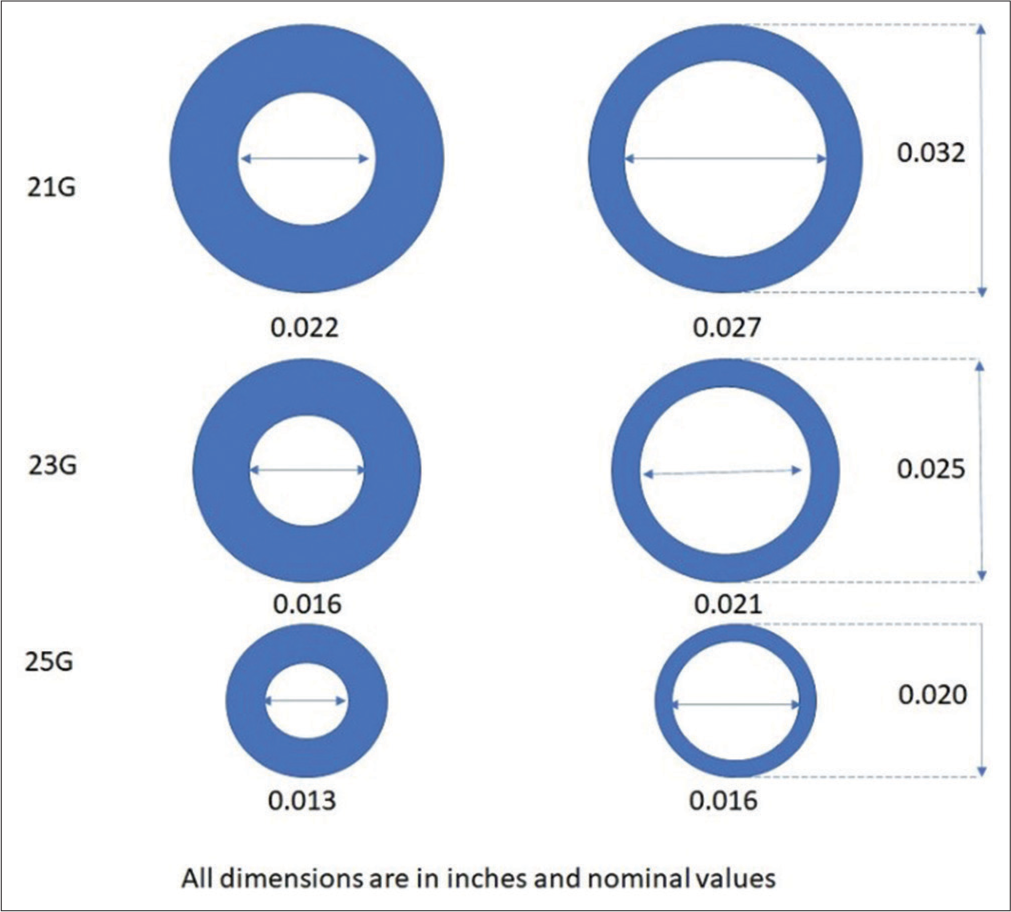
- Becton, Dickinson and Company (BD) right gauge technology.
The present study hypothesized that the use of PentaPoint™ comfort five-bevel IV cannula and RightGauge™ ultra-thin wall technology would lessen pain perception [Figure 2].
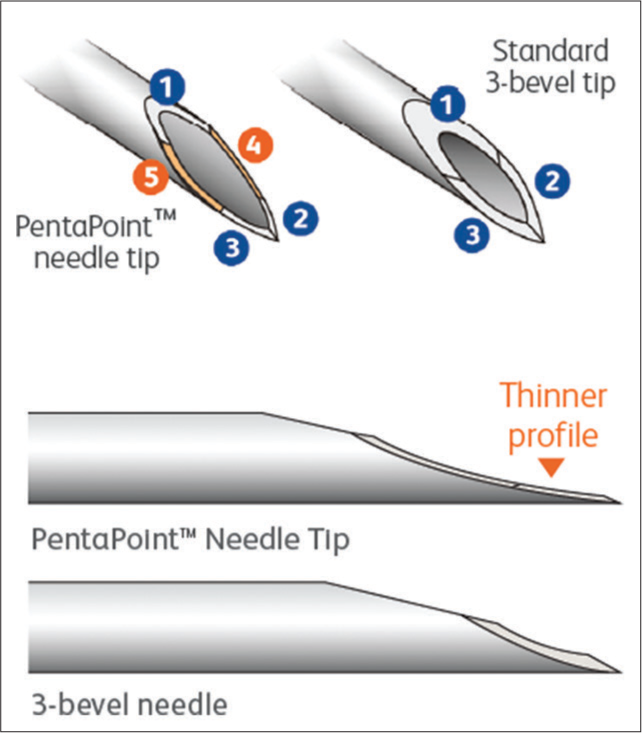
- Pentapoint™ needle tip.
MATERIAL AND METHODS
In this study children (upto 16 years of age) presenting consecutively to the out patient department (OPD) of Bai Jerbai Hospital for Children for blood sampling, for various investigations, were asked to provide a proforma based feedback on the procedure in terms of pain and overall experience. Parents of children less than 7 years of age filled the proforma by orally consenting with the child. Children between 7 to 16 years of age filled the proforma by themselves. The study purpose and process was explained to both parents and children prior to the blood sampling and an informed consent was taken.
The entire process was conducted in accordance with the hospital’s protocol, in compliance with quality statement of the institute. As it was a proforma based audit to understand the blood sampling practice at our institution, Institutional Review Board approval was not obtained. Moreover, no personal information was collected from the participants in this survey. Participants took part in the survey at their discretion and anonymously with due consent. Venipuncture was performed using UTPBBCS-PAH (25G) needle, and feedback was collected after the procedure.
Feedback proforma included two questions in relation to differences in perception of pain: (a) Intensity of pain experienced during previous blood draws, if any. (b) Intensity of pain experienced during blood draws with this new technology. Two other questions related to perception of the device UTPBBCS PAH (25G) were (a) If offered a less painful experience, I am willing to pay for it. (b) The new device UTPBBCS-PAH provided me with a pleasant blood collection experience.
Children or their accompanying parents were asked to rate on the pain scale. Feedback on Pain perception was collected on a categorical scale ranging from 0 to 5 [Table 1 and Figure 3], commonly referred to as the “verbal pain intensity scale” [Table 1].[23]
| Verbal pain intensity scale | Likert scale | ||
|---|---|---|---|
| Pain intensity | Score | Concordance | Score |
| No hurt | 0 | Strongly disagree | 1 |
| Hurts little bit | 1 | Disagree | 2 |
| Hurts little more | 2 | Neutral | 3 |
| Hurts even more | 3 | Agree | 4 |
| Hurts whole lot | 4 | Strongly agree | 5 |
| Hurts worst | 5 | ||
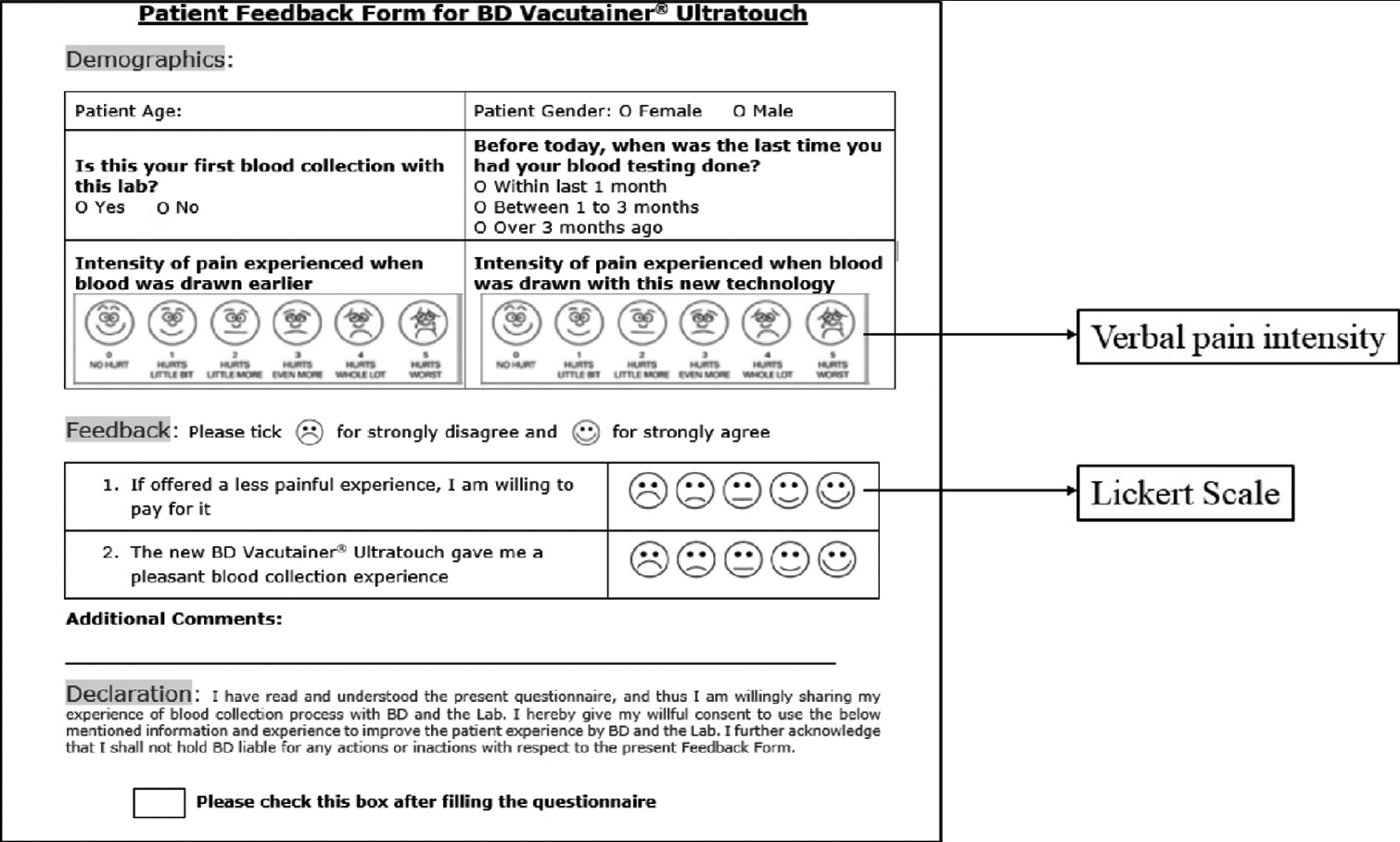
- Feedback form.
The feedback regarding the new device UTPBBCS-PAH was obtained using Likert scale [Table 1][24] comprising of 5 points: “strongly agree,” “agree,” “neutral,” “disagree,” and “strongly disagree.”
If the child strongly agrees, the score was set to 5, while a response of strongly disagrees was scored as 1. The scoring system was modified to included scores of 1 and 2 categorized as “disagree” and scores of 4 and 5 as “agree.” The present study also collected feedback from returning patients.
Compliance and ethical standards
All individuals were explained in detail about the study and consent was taken. The study was conducted according to laboratory compliance and ethical standards.
Statistical analysis
t-test and Chi-square were done to analyze the rating using an online calculator (social science statistics). P ≤ 0.05 was considered significant.
RESULTS
Thirty-three pediatric patients presented consecutively for blood sample collection during the study period and consented to participate. Twenty of them had come back to our OPD for repeat blood sampling within 3 months. There were 22 (66.67%) male and 11 (33.33%) female children. The median age was 9 years, ranging from 0.3 years to 16 years. Sixteen (48.5%) individuals were less than 7 years of age and 17 (51.5%) were more than 7 years of age [Table 2]. The venipuncture was done with 25G UTPBBCS-PAH needle. Figure 4 shows the pain intensity plotted against the age. The pain intensity with the 25G UTPBBCSPAH needle was less than the previous experience P < 0.00001 [Table 3].
| Male | 22 (66.67%) |
| Female | 11 (33.33%) |
| Median age (range) | 9 (0.3–16) |
| 0–7 years | 16 (48.5%) |
| >7–16 years | 17 (51.5%) |
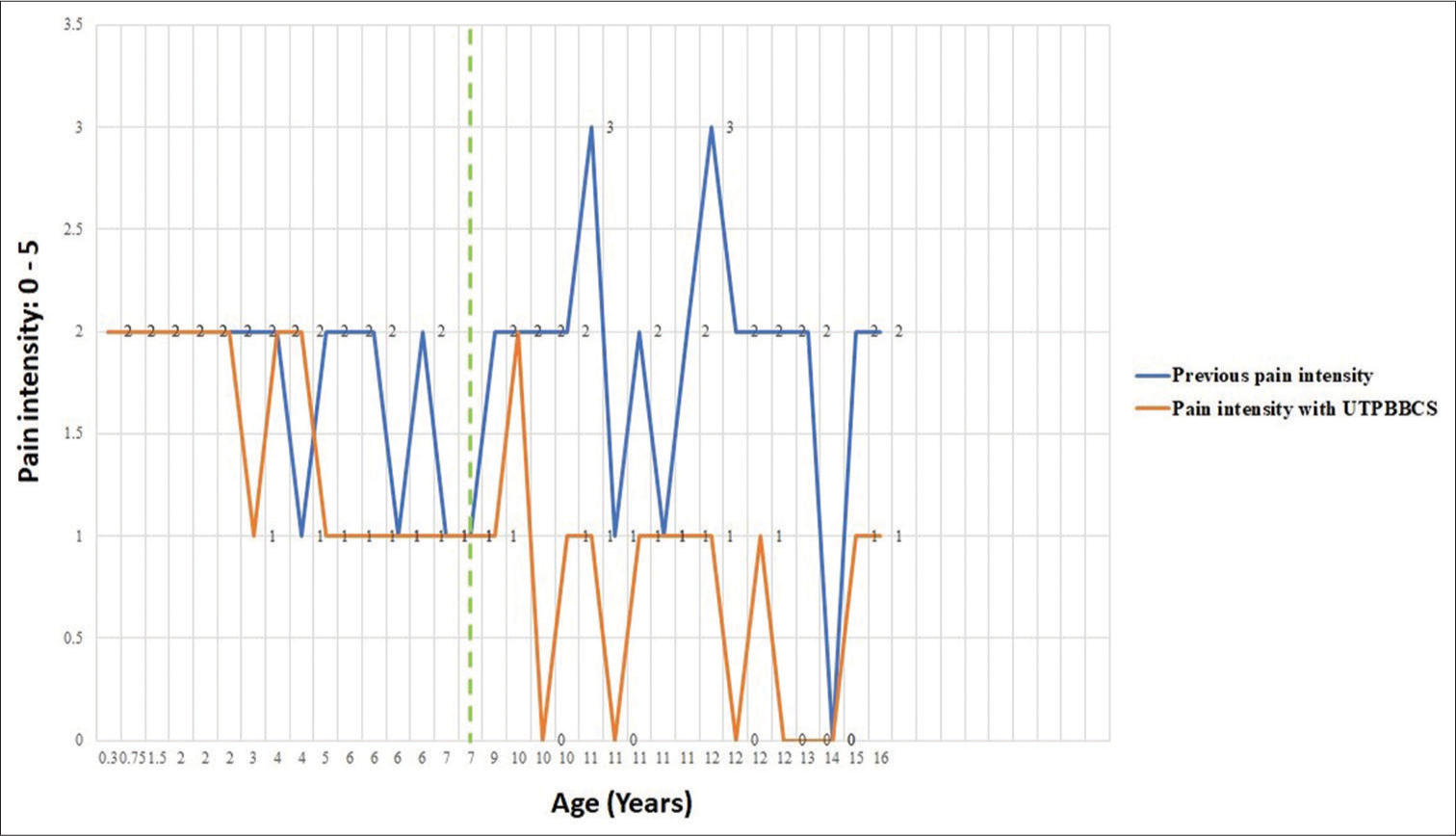
- Pain intensity comparison previous versus UTPBBCS-PAH.
- UTPBBCS-PAH: UltraTouch™ push button blood collection set with pre-attached holder.
| S. No. | Age (yrs)* | Gender | Is this your first collection with this lab | Previous pain intensity | Pain intensity with UTPBBCS | P-value |
|---|---|---|---|---|---|---|
| 1. | 0.3 | M | Yes | 2 | 2 | <0.00001 |
| 2. | 0.75 | F | No | 2 | 2 | |
| 3. | 1.5 | F | No | 2 | 2 | |
| 4. | 2 | M | Yes | 2 | 2 | |
| 5. | 2 | M | No | 2 | 2 | |
| 6. | 2 | M | No | 2 | 2 | |
| 7. | 3 | F | No | 2 | 1 | |
| 8. | 4 | M | Yes | 2 | 2 | |
| 9. | 4 | F | No | 1 | 2 | |
| 10. | 5 | M | Yes | 2 | 1 | |
| 11. | 6 | M | No | 2 | 1 | |
| 12. | 6 | F | No | 2 | 1 | |
| 13. | 6 | M | No | 1 | 1 | |
| 14. | 6 | M | No | 2 | 1 | |
| 15. | 7 | F | Yes | 1 | 1 | |
| 16. | 7 | F | Yes | 1 | 1 | |
| 17. | 9 | M | No | 2 | 1 | |
| 18. | 10 | M | Yes | 2 | 2 | |
| 19. | 10 | M | Yes | 2 | 0 | |
| 20. | 10 | M | No | 2 | 1 | |
| 21. | 11 | F | Yes | 3 | 1 | |
| 22. | 11 | M | No | 1 | 0 | |
| 23. | 11 | M | Yes | 2 | 1 | |
| 24. | 11 | F | Yes | 1 | 1 | |
| 25. | 11 | F | No | 2 | 1 | |
| 26. | 12 | M | Yes | 3 | 1 | |
| 27. | 12 | F | No | 2 | 0 | |
| 28. | 12 | M | No | 2 | 1 | |
| 29. | 12 | M | No | 2 | 0 | |
| 30. | 13 | M | Yes | 2 | 0 | |
| 31. | 14 | M | No | 0 | 0 | |
| 32. | 15 | M | No | 2 | 1 | |
| 33. | 16 | M | No | 2 | 1 | |
| Mean | 1.8 | 1.09 |
Interestingly, in children less than 7 years of age, the distinction between previous and current experience was not clearly evident [Figure 4]. The possible reasons could be that as the response provided was an indirect one and an interpretation of parents, the distinction of pain intensity was not clearly identified. Also recall of experiences could be limited in younger children and comparing and discriminating different experiences may not be clear to them.
Although differences of pain intensity were not statistically significant [P = 0.27, Table 4a] for children less than 7 years of age, pain intensity with UTPBBCS-PAH was significantly lower in children older than 7 years. P = 0.000029 [Table 4b].
| Age group | High | Low | P-value |
|---|---|---|---|
| Previous pain intensity | 12 | 4 | 0.27 |
| Pain intensity with UTPBBCS | 8 | 8 |
Yrs: Years. UTPBBCS: UltraTouch™ Push Button Blood Collection Set
| Age group | High | Low | P-value |
|---|---|---|---|
| Previous pain intensity | 13 | 4 | 0.000029 |
| Pain intensity with UTPBBCS | 1 | 16 |
Yrs: Years. UTPBBCS: UltraTouch™ Push Button Blood Collection Set
t-test revealed no significant difference in the mean score neither of their willingness to pay extra for UTPBBCSPAH nor the pleasant blood collection experience (P = 0.315). The hypothesis was, if the experience was good, the score will be higher, and the patient will be willing to pay [Table 5].
| S. No. | Age (yrs) | Gender | Is this your first collection in this lab | If offered less painful experience, I am willing to pay | Blood collection experience was pleasant with UTPBBCS | P-value |
|---|---|---|---|---|---|---|
| 1. | 0.3 | M | Yes | 5 | 4 | 0.315 |
| 2. | 0.75 | F | No | 3 | 3 | |
| 3. | 1.5 | F | No | 4 | 4 | |
| 4. | 2 | M | Yes | 4 | 2 | |
| 5. | 2 | M | No | 4 | 3 | |
| 6. | 2 | M | No | 4 | 4 | |
| 7. | 3 | F | No | 3 | 3 | |
| 8. | 4 | M | Yes | 3 | 3 | |
| 9. | 4 | F | No | 4 | 4 | |
| 10. | 5 | M | Yes | 3 | 4 | |
| 11. | 6 | M | No | 3 | 4 | |
| 12. | 6 | F | No | 4 | 5 | |
| 13. | 6 | M | No | 5 | 5 | |
| 14. | 6 | M | No | 4 | 4 | |
| 15. | 7 | F | Yes | 2 | 3 | |
| 16. | 7 | F | Yes | 5 | 4 | |
| 17. | 9 | M | No | 4 | 4 | |
| 18. | 10 | M | Yes | 3 | 4 | |
| 19. | 10 | M | Yes | 4 | 4 | |
| 20. | 10 | M | No | 4 | 4 | |
| 21. | 11 | F | Yes | 3 | 4 | |
| 22. | 11 | M | No | 4 | 4 | |
| 23. | 11 | M | Yes | 5 | 5 | |
| 24. | 11 | F | Yes | 5 | 5 | |
| 25. | 11 | F | No | 4 | 4 | |
| 26. | 12 | M | Yes | 2 | 4 | |
| 27. | 12 | F | No | 4 | 4 | |
| 28. | 12 | M | No | 4 | 4 | |
| 29. | 12 | M | No | 4 | 4 | |
| 30. | 13 | M | Yes | 4 | 5 | |
| 31. | 14 | M | No | 5 | 5 | |
| 32. | 15 | M | No | 3 | 3 | |
| 33. | 16 | M | No | 4 | 3 | |
| Mean | 3.8 | 3.9 |
In the present study, the returning patient responses were separately analyzed to understand the need for process improvement. Twenty patients came back to the hospital within 3 months for blood testing. Interestingly, the mean score of previous pain experience at the Outpatient department blood sample collection was 1.75 and now with UTPBBCS-PAH was 1.05. This was statistically significant P = 0.0005 [Table 6 and Figure 5]. Furthermore, there were no significant differences in the mean score of their willingness to pay extra for UTPBBCSPAH and pain experience [P = 0.5, Table 6 and Figure 5]. The pain intensity was plotted against the age [Figure 5].
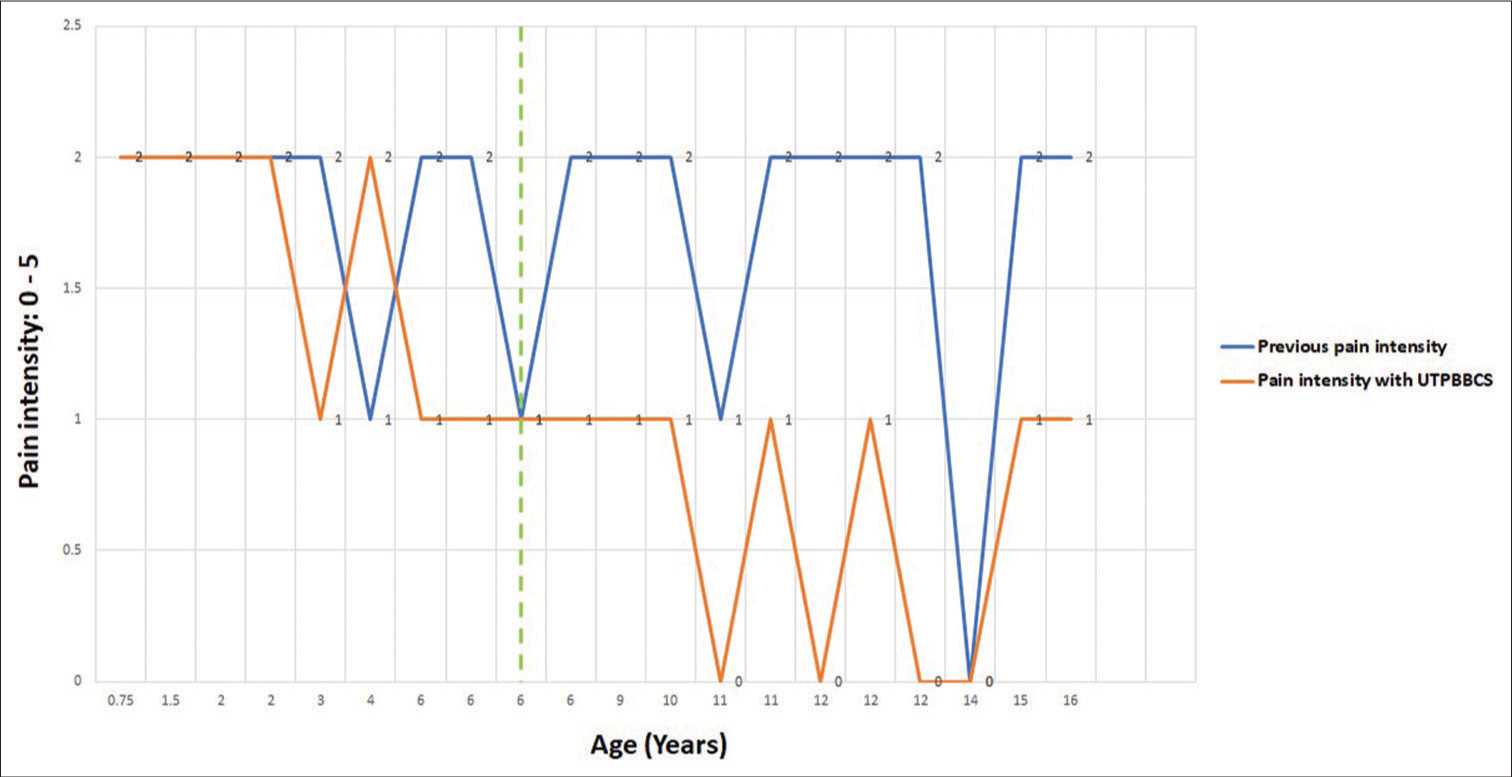
- Pain intensity comparison among returning patients.
| S. No. | Age (Yrs) |
Gender | Is this your first collection in this lab | Previous pain intensity |
Pain intensity with UTPBBCS |
P-value | If offered less painful experience, I am willing to pay | Blood collection experience was pleasant with UTPBBCS | P-value |
|---|---|---|---|---|---|---|---|---|---|
| 1. | 0.75 | F | No | 2 | 2 | 0.0005 | 3 | 3 | 0.5 |
| 2. | 1.5 | F | No | 2 | 2 | 4 | 4 | ||
| 3. | 2 | M | No | 2 | 2 | 4 | 3 | ||
| 4. | 2 | M | No | 2 | 2 | 4 | 4 | ||
| 5. | 3 | F | No | 2 | 1 | 3 | 3 | ||
| 6. | 4 | F | No | 1 | 2 | 4 | 4 | ||
| 7. | 6 | M | No | 2 | 1 | 3 | 4 | ||
| 8. | 6 | F | No | 2 | 1 | 4 | 5 | ||
| 9. | 6 | M | No | 1 | 1 | 5 | 5 | ||
| 10. | 6 | M | No | 2 | 1 | 4 | 4 | ||
| 11. | 9 | M | No | 2 | 1 | 4 | 4 | ||
| 12. | 10 | M | No | 2 | 1 | 4 | 4 | ||
| 13. | 11 | M | No | 1 | 0 | 4 | 4 | ||
| 14. | 11 | F | No | 2 | 1 | 4 | 4 | ||
| 15. | 12 | F | No | 2 | 0 | 4 | 4 | ||
| 16. | 12 | M | No | 2 | 1 | 4 | 4 | ||
| 17. | 12 | M | No | 2 | 0 | 4 | 4 | ||
| 18. | 14 | M | No | 0 | 0 | 5 | 5 | ||
| 19. | 15 | M | No | 2 | 1 | 3 | 3 | ||
| 20. | 16 | M | No | 2 | 1 | 4 | 3 | ||
| Mean | 1.75 | 1.05 | 3.9 | 3.9 |
The mean pain intensity score with UTPBBCS-PAH was 1.09, 39% less than the previous pain intensity.
DISCUSSION
The UTPBBCS-PAH features a larger inner diameter cannula, as shown in Figure 1. This design allows for faster flow and shorter fill times while maintaining sample quality. It can confidently downsize to a 25G UTPBBCS, making it easier to access difficult veins and resulting in improved fill times compared to other devices. In addition, the PentaPoint™ comfort bevel reduces insertion pain, lowering penetration force by up to 32% when compared to a 3-bevel cannula [Figure 2].[20] As previously stated, UTPBBCS-PAH (25G) improves the rate of successful venipunctures with complex patient populations while statistically significantly reducing insertion force and overall pain during blood collection, without compromising efficiency and sample quality.”[25,26] The UTPBBCS is FDA-approved and indicated for general use, including patients with difficult venous access (DVA).[27]
The present study found that UTPBBCS-PAH provides a less unpleasant blood collection experience and significantly reduces the pain [P < 0.00001, Tables 3 and 5 and Figure 4]. This reduction in pain is attributed to the decreased penetration force (up to 32%) and thinner outer diameter of the UTPBBCS-PAH. Interestingly, parents expressed a willingness to pay more for this device as it offers better and less traumatic blood collection experience. However, pain ratings were not as clear for younger children (approximately 7 years) due to the indirect feedback collection through parents and younger children’s ability to accurately access the degree of pain. Conversely, this was different for older children who were more attentive to the degree of pain experienced during the procedure, and their feedback was directly collected.
Furthermore, the pain was reduced by 39% with UTPBBCSPAH (Mean pain: 1.09) compared to the previous experience (Mean pain score: 1.75). This aligns with the earlier finding that the penetration force was reduced by 32% with the UTPBBCS.[20]
CONCLUSION
Venepuncture is one of the most common phlebotomy practices and can be a highly traumatic experience for the pediatric population. Current venepuncture tools are not primarily focused on providing a less traumatic experience, especially for patients with DVA. The BD Vacutainer® UTPBBCS-PAH is specifically designed to improve access to difficult veins while reducing the penetration force. The set is designed with features such as the PentaPoint™ comfort bevel, a thin outer diameter, and a larger inner diameter. These design elements contribute to a less traumatic and less painful blood collection method. Therefore, the UTPBBCS was useful blood collection device for the pediatric population.
Ethical approval
Institutional Review Board approval is not required.
Declaration of patient consent
The authors certify that they have obtained all appropriate patient consent.
Conflicts of interest
There are no conflicts of interest.
Use of artificial intelligence (AI)-assisted technology for manuscript preparation
The authors confirm that there was no use of artificial intelligence (AI)-assisted technology for assisting in the writing or editing of the manuscript and no images were manipulated using AI.
Financial support and sponsorship
Nil.
References
- Clinical implications of unmanaged needle-insertion pain and distress in children. Pediatrics. 2008;122(Suppl 3):S130-3.
- [CrossRef] [PubMed] [Google Scholar]
- Comforting strategies and perceived barriers to pediatric pain management during IV line insertion procedure in Uganda's national referral hospital: A descriptive study. BMC Pediatr. 2015;15:122.
- [CrossRef] [PubMed] [Google Scholar]
- Distraction for children of different ages who undergo repeated needle sticks. J Pediatr Oncol Nurs. 2002;19:22-34.
- [CrossRef] [PubMed] [Google Scholar]
- Ameliorating adults' acute pain during phlebotomy with a distraction intervention. Appl Nurs Res. 1997;10:168-73.
- [CrossRef] [PubMed] [Google Scholar]
- Clinical report: Blind intubation for upper airway obstruction. Anaesth Intensive Care. 1978;6:361-2.
- [Google Scholar]
- Cardiac arrest; review and report of 12 cases. Ann Surg. 1952;135:376-93.
- [CrossRef] [PubMed] [Google Scholar]
- Fatalities from immunotherapy (IT) and skin testing (ST) J Allergy Clin Immunol. 1987;79:660-77.
- [CrossRef] [PubMed] [Google Scholar]
- Toxic erythema; T.A.B. (intravenously); coronary thrombosis; sudden death. Br J Dermatol Syphilis. 1939;51:318-21.
- [CrossRef] [Google Scholar]
- Bradycardic rhythms during peritoneal dialysis. Arch Intern Med. 1971;128:445-7.
- [CrossRef] [PubMed] [Google Scholar]
- The risk of adverse reactions from percutaneous prick-puncture allergen skin testing, venipuncture, and body measurements: Data from the second national health and nutrition examination survey 1976-80 (NHANES II) J Allergy Clin Immunol. 1989;84:886-90.
- [CrossRef] [PubMed] [Google Scholar]
- Fatality in a blood donor; a case report, with a review of the literature. Ann Intern Med. 1947;26:603-8.
- [CrossRef] [PubMed] [Google Scholar]
- Butterfly needles reduce the incidence of nerve injury during phlebotomy. Arch Pathol Lab Med. 2012;136:352.
- [CrossRef] [PubMed] [Google Scholar]
- Evaluation of pain and specimen quality by use of a novel 25-gauge blood collection set with ultra-thin wall cannula and 5-bevel tip design. J Appl Lab Med. 2017;2:201-10.
- [CrossRef] [PubMed] [Google Scholar]
- A randomized control trial on the effect of needle gauge on the pain and anxiety experienced during radial arterial puncture. PLoS One. 2015;10:e0139432.
- [CrossRef] [PubMed] [Google Scholar]
- Influence of the needle bore size used for collecting venous blood samples on routine clinical chemistry testing. Clin Chem Lab Med. 2006;44:1009-14.
- [CrossRef] [PubMed] [Google Scholar]
- Pain scale. Available from: https://www.healthline.com/health/pain-scale [Last accessed on 2023 May 16]
- [Google Scholar]
- Likert scale. Britannica. Available from: https://www.britannica.com/topic/likert-scale [Last accessed on 2023 May 16]
- [Google Scholar]
- Evaluation of tube fill time of the BD Vacutainer® UltraTouch™ push button blood collection set with pentapoint™ comfort bevel and rightgauge™ cannula as compared with the current BD vacutainer® push button blood collection set with thin wall 3-bevel cannula, white paper VS9249 Franklin Lakes, NJ: BD; 2016.
- [Google Scholar]
- Performance evaluation of BD vacutainer® ultratouch™ push button blood collection set and comparison with the current BD vacutainer® push button blood collection set for visual and analytical indicators of hemolysis In: VS9250 white paper. 2015.
- [Google Scholar]
- Making difficult venous access (DVA) easier. Available from: https://maxwell.bd.com/News/467684/ultratouchdva [Last accessed on 2022 Dec 19]
- [Google Scholar]






